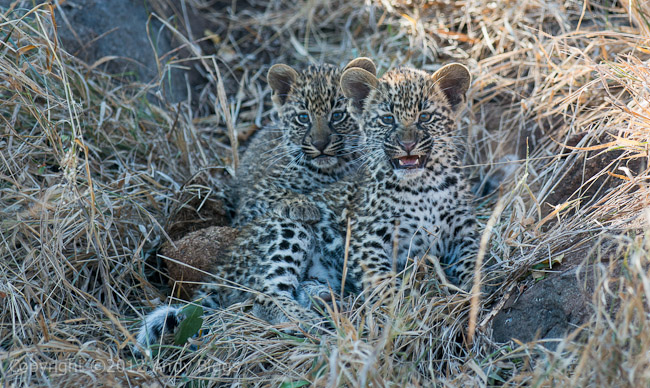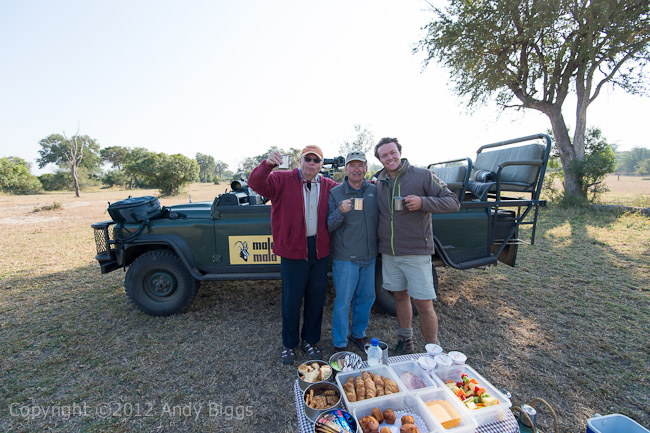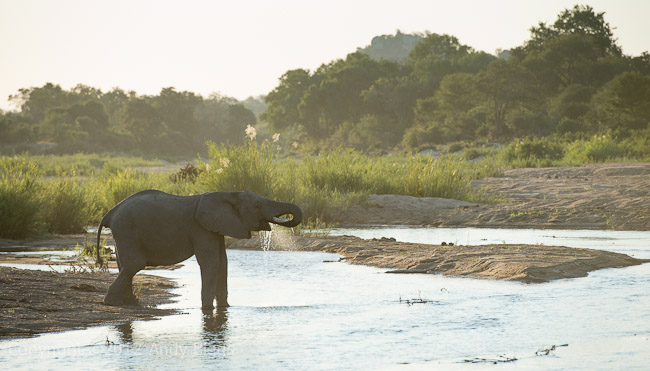Sabi Sands Safari Report - Day 3
 Monday, June 4, 2012 at 06:40AM
Monday, June 4, 2012 at 06:40AM Today we decided to try and track/visit the Kikilezi female leopard with her two cubs, but we knew we needed to wait to visit the den until they had a chance to warm up after the sun came up. We drove the roads towards Clarendon dam in hopes of picking up signs of cheetah, but that turned out to not yield what we had hoped. That gave us some time for the day to heat up a bit, and when we arrived at the leopards the two cubs were racing around and as active as I have ever seen. The cubs were about 8 weeks old, and as a result have a schedule of playing, sleeping and nursing with their mother. So our time was filled with playing, and after they settled down after an hour we decided to move on. We did revisit the cubs in the late afternoon, however we had better memories than photographs due to the dense vegetation that was in the way.
Ok, let’s chat about cameras for a few moments. I have the new Nikon D4 and D800 cameras with me, and there are some major differences between the two that should be noticed. Since I only have a few minutes to write this entry between game drives, I am going to use a bullet point format to explain.
D800
- Camera is too small for my hands, and will need to purchase the portrait grip.
- Resolution is absolutely stunning.
- The ability to crop an image, as the result of an absurd amount of pixels, is fantastic.
- Low frames per second works for me, but might not work for somebody who is less familiar with African wildlife photography. I tend to shoot only when I need to, as opposed to letting the camera rip off 20 shots.
- Autofocus is pretty darned goof for a $3,000 camera. I am not seeing any differences between the D800 and my old D3, D3x and D700 cameras.
- I am not a fan of the new autofocus mode switches. I wish we still had a switch on the back of the camera, as opposed to having to use the A/M switch and button on the front of the camera. This is a step backwards.
- I am finding that ISO 1600 is my limit, which is similar to what I did with my D3x. ISO 800 or lower is more ideal, but 1600 seems to be the edge of the breaking point.
D4
- The best camera ergonomics of any camera I have ever used
- I absolutely love the autofocus joysticks for both normal and portrait modes. This was sorely lacking in previous cameras.
- I like the nice balance between file size, dynamic range and high ISO capabilities. ISO 6400 is turning out to be my limit, but 1600 and 3200 seem to be more common over the past 3 days since I began using the camera.
- I do wish the D4 had two identical compact flash slots. Boooooo
It was a fantastic day, filled with leopard cubs as well as general game! Until tomorrow…..

Cubs of the Kikilezi Female Leopard
Nikon D800, 300mm f/2.8, 1/500 @ f/5, ISO 400

Breakfast In The Bush
Nikon D4, 16-35mm, 1/800 @ f/5.6, ISO 400

Matt, Terry and Jim
Nikon D4, 70-200mm f/2.8 VRII, 1/160 @ f/8, ISO 250

Elephant and the Sand River
Nikon D4, 70-200mm f/2.8 VRII, 1/640 @ f/5.6, ISO 250
Camera bags on this safari are sponsored by Gura Gear, which I started in 2008. Check us out. We make the best camera bags on the planet.
Some of the gear on this safari has been provided by Borrowlenses.com. I rely on borrowlenses.com for both my own needs as well as my safari travelers’ needs. When we need big lenses, cameras or anything else photographic, we turn to borrowlenses.com to help out. They are the best resource in the industry for traveling photographers.
 Mala Mala,
Mala Mala,  Sabi Sands,
Sabi Sands,  South Africa,
South Africa,  Workshop,
Workshop,  safari in
safari in  Safari Reports
Safari Reports 


Reader Comments (3)
What steers you away from going higher in ISO on either camera? Is it related to how large you can print and retain detail without using noise reduction software?
Another great day, cubs, good looking breakfast and all those loooong lenes you can't go wrong. Be safe. Regards Peter
Peter, I just use the lowest ISO that I need to. No need to jack it up to a high value just because I can. I start at 400 and work my way up, and I only move up if my shutter speed is too low or if I cannot get enough depth of field at a certain shutter speed.